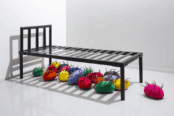[dropcap style=”font-size:100px; color:#992211;”]A[/dropcap]nd so there is direct value/function/utility in nothingness and forgetting because we cannot really invent without it. We cannot go outside of ourselves to think, create and analyse. We cannot connect if we are made only of weighted nuclei.
We need space. Thus, we have the intimacy of symbols and abstraction handed down by sages, artists and humble teachers to help us negotiate through unknowable realities.
The I Ching, over 5,000 years old, is a wisdom and oracle text. The participant approaches the oracle with a question, simple or complex, and performs a ritual of throwing coins or yarrow stalks. The outcome of this ritual creates one of 64 possible
hexagonal diagrams. Each hexagram has a corresponding chapter in the text. The participant proceeds to read that chapter in the context of receiving some wisdom on the question they approached the oracle with. Carl Jung writes in his foreword to the Richard Wilhelm translation:
“With us (the Western reader) it would be a banal and almost meaningless statement to say that whatever happens in a given moment possesses inevitably the quality peculiar to that moment. This is not an abstract argument but a very practical one. There are certain connoisseurs who can tell you merely from the appearance, taste, and behaviour of a wine the site of its vineyard and the year of its origin […] in the face of such facts, it must be admitted that moments can leave long lasting traces.”

, 2018, Oil on Canvas, 150cm x 90cm © Trate
Here we are struck with the very physical nature of the moment. Jung continues in his foreword to point out how the Chinese text defies Western notions of linear time and strict causal solutions to psychological problems because the oracle itself requires participation,
i.e. one’s presence is affecting space-time; one cannot be a mere observer. Whereas the Western mind would be concerned with the testable limits of such a text, more than likely turning to recurring A + B = C solutions to resolve psychological dilemmas, the ancient Chinese mind seems to be able to assess problems from a malleable ever-present. The fall of the stalks or coins infers upon the moment its own reality, cooperating with the participant and endowing the moment with guidance symbolically tied to the inner query of the participant. This point of view suggests that it is possible to imbue value upon an object in order to engage in a meaningful relationship with it, serving the intention of learning or receiving more information from the unconscious or imagination. Surely paintings themselves are these kinds of object; the bordered arenas upon which we dance and debate with the figures of our inner life after the artist has done just the same, breathing our archetypes into figures and symbols, untangling our thoughts in waves of light and colour, covering, recovering, revealing, unfolding, telling secrets. How many secrets does Madonna hold safe for her admirers?
This is where ongoing, fundamental materialist questions, ‘what is matter?’ ‘What is it made of?’ transcend to the realm of interaction and psychic function. What is my relationship to matter (space-time)?
How is it affecting me and how can I change it?
So why not let the testing ground be one’s own body, or the world itself? One only needs to look at the feats of Wim Hof, who was able to climb Mount Everest in nothing but a pair of shorts and run a marathon through a desert without taking a drink of water, to understand that a form of creative mastery and augmenting of the fundamental anatomical reality is possible. Wim Hof is certainly a kind of biological artist, no doubt a comprehensive dreamer of the body and an inspiring legend, however, let’s focus more on two masters of performance: Stelarc and Philippe Petit.
shifting the function of that space in the heart of his viewer
Stelarc, the Cyprus-born, Australian artist is famous for his body suspension works. He pierces his skin with a series of hooks attached to steel cables that then suspend the
artist in space, sometimes publicly, sometimes privately. From Stelarc’s website, describing his 1985 City Suspension above the Royal Theatre of Copenhagen:
‘Connected to steel cables, the body was hoisted to the midpoint of the crane arm, shuttled to the end, then rotated 4 times thru 180 degrees for a 24 minute suspension. The body was constantly vibrating from the wind, sometimes swinging and spinning on its axis. Maximum body height was 56 metres above street level.’
Hanging from a crane already has its implications. Stelarc is simultaneously showing the body as a conquered object uprooted and excavated from nature, whilst also heightening the body’s absolute, unexplored potential; casting his freedom over the city, the human landscape made physical reality Stelarc is many things but not least inspirational for reminding the viewer that at the heart of inner space is malleability, that the apparent physical limits of space can be transcended, that the apparent nothingness need not only produce a grain of rice but perhaps a tidal wave inside a crystal ball when it so needs.
Philippe Petit’s wire walks also elucidate a kind of public, visual poetry in perhaps a more whimsical fashion. Walking an illegal tightrope between the late twin towers of Manhattan, Petit is ‘taking’ the sky. He is broadcasting his right to occupy the line between these mega structures and in doing so, occupies a space that no one ever had before, shifting the function of that space in the heart of his viewer. From then on, everyone can imagine themselves in the sky, conquering a previously restricted, unimagined space now rendered a little Atlantis in the sky above NYC. Here, space-time is visible and felt, the symbiotic elements congealing in a surreal network of eternal freedom and watering down of commercial value. The reader may start to see these artists as grains of rice, radiating within the public stadium.
These performances can fundamentally change the inner core of their viewer, spilling us on the floor like coins or yarrow stalks, recasting us into space-time itself with an entirely altered perspective of what is possible and worthwhile.
We are made aware not only of the malleable potential of the body itself but more so, how a concentrated belief and practice in abstract mediums can focus the direction of one’s inner being towards realising something previously thought to be impossible and/or completely unique. These achievements, particularly when they are poetic or artistic can have a considerable impact on what we choose to pursue in our lives, how we spend each day and what we dream of at night,
i.e. they are the stuff of inspiration. In this way, the artist does not just reorganise nature but rather, never quite trusts it, and will thus seek its augmentation by testing its absolute limit, becoming the ambassador for this wondrous, new experiment. And so, let me push these ideas into their corner:
“All who live in corners will come to confer life upon this image, multiplying the shades of being that characterise the corner dweller. For to great dreamers of corners and holes nothing is ever empty, the dialectics of full and empty only correspond to two geometrical non-realities. The function of inhabiting constitutes the link between full and empty. A living creature fills an empty refuge, images inhabit, and all corners are haunted if not inhabited.” The Poetics of Space, Gaston Bachelard (1957)
Take the corners of Raphael and Picasso; the acuteness with which they underpin the spherical and cubist depth of the image, non-realities made real, forming the arena of the painting. In so, they are the corners of the mind, the intimate places from which a character or an ornament may appear, or the boundary within which the subjects inhabit and protect their value. These corners may be physical, intimate expressions of the artist but over time, they also become the corners of specialisation, given our constant review and reiteration of these artworks. In this way, we know them too well; the paintings are changed by the exaltation of their cultural significance. But no, those artists are not perfect, they too are cornerstones of a larger cultural story. It helps to envision those paintings being made in a studio, over a period of days/months/years, and that they contain all kinds of hidden intimacy and imprecision. The key is to fundamentally shift people’s idea of what is possible and acceptable so they can feel better about changing their own reality; organising the coalescence of space-time so there is more of it to access. Artists push ideas to their furthest extremities before they rest or turn back to openness.
If we are talking of extremities, what better place to consider than the hands and fingers. Are your hands open or closed? Are they clenched? Do you point, or does the hand gesture softly? Are these physicalisations the body’s interpretation and communication of our inner feelings? Of course. Working backwards, one may open the clenched hand and in turn open a new thought; softer, more generous, made possible by the physical shift in the hand’s expression, one may paint something then, or just breathe a bit easier. A lover of a Picasso or Raphael might feel the corners of their own mind begin to rise up, crumble apart or disappear entirely to reveal some other vista the corner was previously concealing or protecting. From the I Ching to interaction with art,there is always some ability to enact a shift, to conjure an altered perspective that improves or lightens the circumstances.
In these corners of space-time we uphold the continuum of the infinite. A winemaker carries on the traditions of their former masters, not simply in theory but in physicality; they commit the same actions, slightly augmented. These repeated actions develop tradition. The winemaker of today can transmute themselves into the lives and visions of all the winemaker’s that ever lived, not just through daydreams but through physical gesture, open to shared dreaming. It is here that despite a love of Raphael’s paintings, a contemporary artist may be more intrigued by gaining access to that artist’s scribble on an arbitrary scrap of paper. For the great masterpieces confer a compendium of all the deep reserves of talent and experiment brought forth by the artist but in some way (like an idea), they hide within them the direct inference of a momentary thought or mood. Perhaps it becomes more intriguing to wonder how Raphael felt, what kind of character he was, and the best way to discover that is by observing some accident, some irreverent article left behind from the unconscious. A winemaker cannot learn all the knowledge, context, and art of their former masters directly, but through honouring their traditions and techniques, the contemporary may possess and enter the tangible dream-reality of sharing in the continuum of their choices, tastes, textures, challenges and solutions. The dream memory suffices for that of a recordable one, for it creates the void, which instills the urge to carry on, refine, and perhaps hold still the cheesy nucleus, marking the perimeter that stops the nothing from escaping.
“Logic will get you from A to B. Imagination will take you everywhere…. Never give up on what you really want to do. The person with big dreams is more powerful than the one with all the facts.” – Einstein
Precious Nothing Part 1 / Part 2 / Part 3
References
Bachelard, G. ‘The Poetics of Space’ (1957) Borges, J.L. ‘Funes; His Memory (1942).
Jung, C. ‘The IChing or Book of Changes’, Wilhelm translation (1950) koeniggalerie.com
Read more on Art, Time and Space in Trebuchet 6
Nicholas Millen is an artist, gallerist and writer currently living and working in London.




















